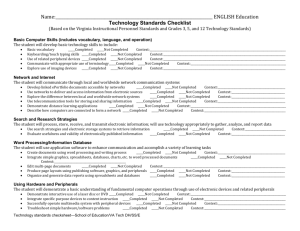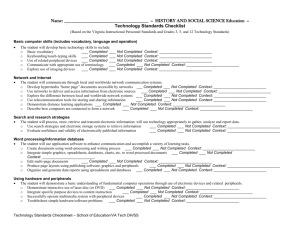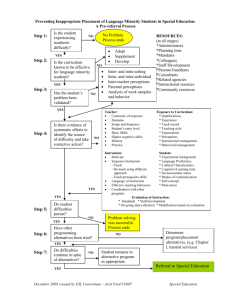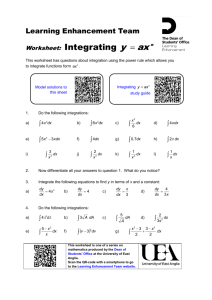A Study of Teacher Perceptions of Instructional Technology
advertisement
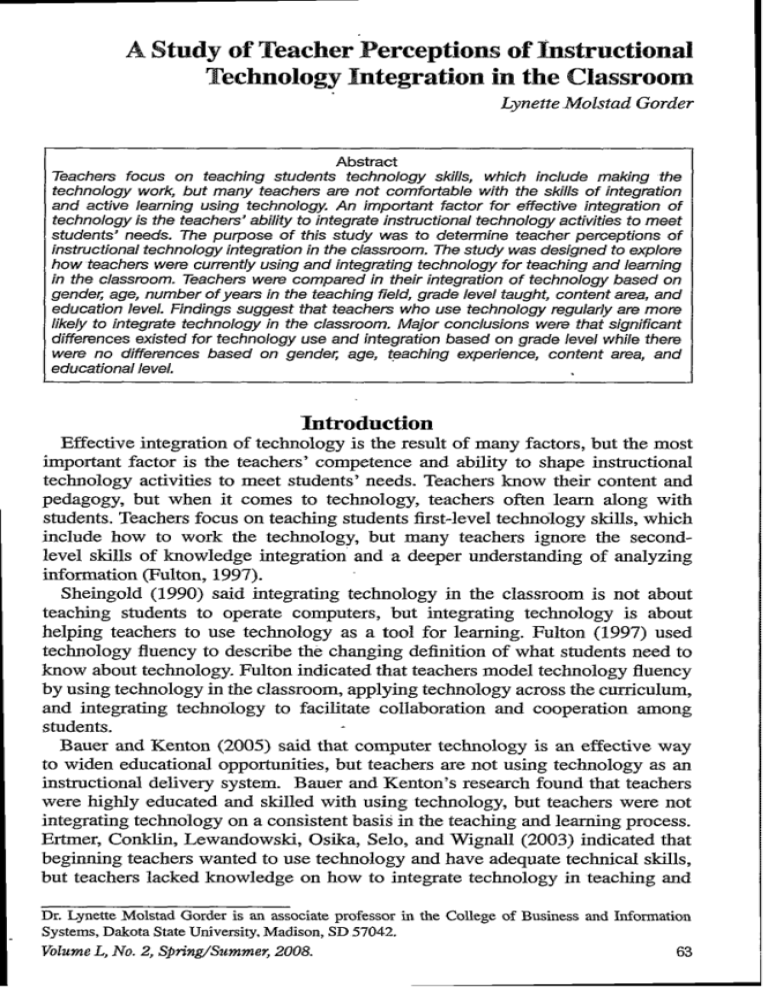
A Study of Teacher Perceptions of Instructional Technology Integration in the Classroom Lynette Molstad Gorder Abstract Teachers focus on teaching students technology skills, which include making the technology work, but many teachers are not comfortable with the skills of integration and active learning using technology. An important factor for effective integration of technology is the teachers' ability to integrate instructionaltechnology activities to meet students' needs. The purpose of this study was to determine teacher perceptions of instructionaltechnology integrationin the classroom. The study was designed to explore how teachers were currently using and integrating technology for teaching and learning in the classroom. Teachers were compared in their integration of technology based on gender, age, number of years in the teaching field, grade level taught, content area, and education level. Findings suggest that teachers who use technology regularlyare more likely to integrate technology in the classroom. Major conclusions were that significant differences existed for technology use and integrationbased on grade level while there were no differences based on gender, age, teaching experience, content area, and educationallevel. Introduction Effective integration of technology is the result of many factors, but the most important factor is the teachers' competence and ability to shape instructional technology activities to meet students' needs. Teachers know their content and pedagogy, but when it comes to technology, teachers often learn along with students. Teachers focus on teaching students first-level technology skills, which include how to work the technology, but many teachers ignore the secondlevel skills of knowledge integration and a deeper understanding of analyzing information (Fulton, 1997). Sheingold (1990) said integrating technology in the classroom is not about teaching students to operate computers, but integrating technology is about helping teachers to use technology as a tool for learning. Fulton (1997) used technology fluency to describe the changing definition of what students need to know about technology. Fulton indicated that teachers model technology fluency by using technology in the classroom, applying technology across the curriculum, and integrating technology to facilitate collaboration and cooperation among students. Bauer and Kenton (2005) said that computer technology is an effective way to widen educational opportunities, but teachers are not using technology as an instructional delivery system. Bauer and Kenton's research found that teachers were highly educated and skilled with using technology, but teachers were not integrating technology on a consistent basis in the teaching and learning process. Ertmer, Conklin, Lewandowski, Osika, Selo, and Wignall (2003) indicated that beginning teachers wanted to use technology and have adequate technical skills, but teachers lacked knowledge on how to integrate technology in teaching and Dr. Lynette Molstad Gorder is an associate professor in the College of Business and Information Systems, Dakota State University, Madison, SD 57042. Volume L, No. 2, Spring/Summer,2008. 63 LYNETrE MOLSTAD GORDER learning. Technology integration is not a 'one size fits all' (Wepner, Tao, & Ziomek, 2006) where teachers do the same thing for their students or where teachers possess the same specific skills to be competent technology users. Teachers need to know how and why to use technology in meaningful ways in the learning process for technology integration to work. South Dakotaimplemented atechnology integration model called the Technology for Teaching and Learning Academies. Several important objectives of the South Dakota model were that teachers (a) developed technology-supported activities that promote engaged, worthwhile learning, (b) used integration practices related to instructional technology, and (c) modeled life-long learning using technology (Schopp & Rothernel, 2001). The professional development model was to establish a growing cadre of highly trained educators who change teaching and learning through the integration of technology into the curriculum. The Basic TTL Academy was designed as a fourweek academy that provided teachers with skills to use technology effectively as a teaching and learning tool in the classroom. The purpose of the Advanced 'TTL Academy was to provide a two-week academy for educators to build on their skills and abilities presented at the Basic TTL. The T'TL Academies enhanced individual education, helped the state become one large interactive classroom, and equalized technology learning across the state (Schopp & Rothernel, 2001). Related Literature Dockstader (1999) indicated that integrating technology in the classroom is a complex process that includes (a) learning the technology, (b) using technology in the teaching and learning process, and (c) integrating technology to enhance student learning. Sherritt and Basom (1996) said schools were becoming ineffective at preparing students for life and work because the requirements of successful life and work conditions changed. Schools did a good job of educating students for an industrial age but not for the information age. Jaffee (1997) outlined four highly valued pedagogical principles practiced in the classroom where technology is integrated: active learning, mediation, collaboration,and interactivity.Active learning using technology involves student interaction with the content that allows knowledge building and construction. Mediation is interaction between the teacher and the students to solve problems, respond to questions, and discuss topics relating to the course. Collaboration is interaction among students through questions and information sharing. The principle that represented the greatest pedagogical potential for learning using technology is interactivity. Interactivity is the master concept where active participation is building the understanding and knowledge through interaction with other students, teachers, and resources using technology. Active Learning. Alley and Jansak (2001b) identified several characteristics of active learning using technology in the classroom: (a) students engaged in active learning using technology focus attention on the activity and (b) students motivated by using technology actively in different contexts apply the new skills. Barak, Lipson, and Lerman (2006) indicated that using technology for active 64 The DeltaPi EpsilonJournal A STUDY OF TEACHER PERCEPTIONS OF INSTRUCTIONAL TECHNOLOGY learning keeps students focused, engaged, and motivated. Mediation. Schroeder (1993) believed that technology is the mechanism for increasing the amount of human-to-human interaction between teachers and students in the classroom and is used by teachers for interaction to meet the needs of the students' changing learning styles. Hawkey (2002) said information and communication technology enables learners to acquire transferable skills and use their learning styles in the educational process. Fitch (2004> said if the teacherlearner ratio is such that learners do not have opportunities to interact with other students or teachers, technology works to increase interaction. Collaboration.Jurist (1999) found that technology changed teacher practices in teaching and learning because the classroom became more student-centered rather than teacher-centered. Teacher roles moved from lecturer and expert to collaborator and facilitator. Student roles changed from passive listener to collaborator and occasional expert. Educational goals changed from memorization of facts to inquiry, invention, and investigation. Interactivity. Alley and Jansak (2001a) stated that the teachers' best strategy to prepare for teaching is to use important teaching principles, translate these principles into practices, and think creatively while using technology instruction methods. Padgett and Conceicao-Runlee (2000) believed interactive hands-on sessions are critical for mastering new computer technology skills. Pantasiz (2002) indicated that technology-enabled learning is becoming an integral part of the learning process because the power of technology leverages information to eliminate the one-size fits all approach and customizes content to meet individual needs and learning styles. The integration of technology into the course design and assignments is the critical point for using technology to improve learning (Sherer & Shea, 2002). The difference between technology use and technology integration for learning is that integration implies full-time, daily operation within lessons. Integration of technology is dependent on technology for delivery of classroom lessons (Hooper & Rieber, 1999). Technology integration is not about the availability of technology, but more about the teachers' effective use of technology that makes a difference in reforming the classroom. The teacher is the most important ingredient for success when using and integrating technology (Mandell, Sorge, & Russell, 2002). Beckett, Wetzel, Chishlom, Zambo, Buss, Padgett, Williams and Odom (2003) said teachers are central to the creation of a technology-integrated environment that is learner-centered and motivating. Without teachers who can integrate technology, students' exposure to technology remains limited and inequitable. Purpose of the Study The purpose of this study was to examine the degree to which the teachers who have been trained to use and integrate technology into teaching and learning perceive that technology is fully integrated in the classroom. The study also compared teacher perceptions of uses and integration based on personal characteristics. The study helps shape plans for future technology training Volume L, No. 2, Spring/Summer,2008. 65 LYNETTE MOLSTAD GORDER professional development models for integrating technology especially with schools now looking at implementing wireless one-to-one classrooms. The research questions in the study were: 1. How do teachers currently use and integrate technology for teaching and learning in the classroom? 2. How do teachers differ in the extent to which they integrate instructional technology based on the characteristics of gender, age, teaching experience, grade level taught, content area, and educational level? Methodology Population The general population for this study consisted of K-12 teachers who attended the Advanced Technology for Teaching and Learning Academy in South Dakota. The teachers who attended the Advanced TTL Academy also attended the Basic TTL Academies. Approximately 300 South Dakota teachers who completed the Advanced TTL Academy at Dakota State University in Madison, South Dakota, were mailed the survey with two reminders sent by email. Of the 300 teachers who received the survey, 174 returned the survey for a 58.0% response rate. Instrument Mills and Tincher (2003) developed the Technology Integration Standards Configuration Matrix (TISCM) as a model for determining technology integration by teachers. Mills and Tincher's survey was organized and developed by identifying instructional strategies that demonstrate appropriate use of technology for enhancing student learning in the classroom. The instructional strategies were set up along a continuum from using technology as a tool for productivity to using technology for enhancing student learning to using technology as a tool for professional productivity. The process of developing the instrument attempted to show a true and accurate gradient of technology integration with reasonable validity and reliability. The results of the data analysis of the study supported the construct validity of the TISCM and showed that the TISCM was an effective tool to determine technology integration by teachers (Mills & Tincher, 2003). Mills created another version of the Technology Integration Matrix (TICM) that is more user-friendly and emphasizes what teachers do and what students do in a technology-rich classroom (Mills, 2004). The Technology Integration Matrix (TICM) was used in this study to determine technology integration by teachers. Research Question 1 determined how teachers integrate and use technology using 35 survey items. Research Question 2 compared teachers' integration of instructional technology based on characteristics of gender, age, years of teaching experience, grade level taught, content area, and educational level. 66 The Delta PiEpsilon Journal A STUDY OF TEACHER PERCEPTIONS OF INSTRUCTIONAL TECHNOLOGY Data Analysis The demographic data collected included gender, age, teaching experience, grade level taught, content area, and educational level. The demographic characteristics of the teachers completing the survey are shown below: Gender 84% Female 16% Male Age * 51% 47% * 2% Teaching Experience 41% * 48% * 11% Grade Level * 33% * 13% * 33% * 21% Content Area * 17% • 16% * 5% o 17% * 4% * 21% * 20% Educational Level * 62% * 34% * 4% 50 years or more 31-49 years 30 years or less 26 years or more 11-15 years 10 years or less K-5 6-8 9-12 Multiple Grades Business/Computers English/Foreign Language Fine Arts Math/Science Social Studies Multiple Disciplines Other Bachelors Masters Doctorate Findings Findings are presented according to the research questions for the study. The tables are associated with a particular research question. The appropriate mean and standard deviation data are shown for the items on the survey. Responses are listed in the tables in descending order by means. Technology Integrationand Use For the research question on teachers' integration of technology for teaching and learning in the classroom, survey questions 1-18 addressed technology integration in the classroom. Phase 1 (survey questions 1-6) identified teachers as operators who use technology for professional productivity. Phase 2 (survey Volume L, No. 2, Spring/Summer,2008. 67 LYNETTE MOLSTAD GORDER questions 7-12) identified teachers as facilitators who deliver instruction using technology, and Phase 3 (survey questions 13-18) identified teachers as those who integrate technology into student learning. Table 1 shows the technology integration means and standard deviations for the survey questions. The questions are ordered by means within the three phases with teachers' responses on the questions as (1) never, (2) seldom, (3) sometimes, (4) often, and (5) always to technology integration. For Phase 1, respondents agreed most strongly (M= 4.41) that they perform basic file management tasks. For Phase 2, respondents agreed most strongly that they practice and model responsible use of technology (M = 4.26). For Phase 3, respondents agreed most strongly that they use technology resources to provide learning context using problem solving and critical thinking (M = 3.40). The lowest mean for Phase 1 as indicated by the respondents was applying trouble-shooting strategies (M = 3.73). The lowest mean for Phase 2 was demonstrating strategies to assess the validity and reliability of data gathered with technology (M = 3.28), and for Phase 3 the lowest mean was engaging learners in the development of electronic portfolios (M = 2.21). Standard deviations increase as responses get closer to the scale midpoint, while the means decrease. Table 1 Means of Teachers'Integrationof Technology Mean Standard DeSation Perform basic file management tasks 4.41 0.87 Operate common technology 4.20 0.89 Use technology to communicate and collaborate 4.11 0.93 Use software productivity tools 3.83 1.04 Use technology to locate, evaluate, and collect educational research 3.79 0.95 Apply trouble-shooting strategies 3.73 1.01 Survey Question Phase 1 68 The DeltaPi EpsilonJournal A STUDY OF TEACHER PERCEPTIONS OF INSTRUCTIONAL TECHNOLOGY Table 1 (continued) Means of Teachers'Integrationof Technology Phase 2 Practice and model responsible use of technology 4.26 0.84 Facilitate equitable access to technology 4.09 0.95 Manage student learning activities in a technology-enhanced environment 3.95 0.93 Evaluate and select informational and educational 3.72 1.00 Use multiple technology contexts and a variety of productivity tools 3.67 0.96 Demonstrate strategies to assess the validity and reliability of data gathered with technology. 3.28 1.00 Use technology resources to provide learning context requiring the use of problem solving, critical thinking 3.40 0.98 Employ technology with students use to solve authentic problems Implement technology-based learning experiences that utilize a variety of grouping strategies 3.36 1.03 3.35 1.00 Apply multiple methods of evaluation and assessment 3.22 1.02 Use technology resources and productivity tools to collect, analyze, interpret, and communicate learner performance 2.88 1.18 Engage learners in the development of electronic portfolios 2.21 1.19 Phase 3 The composite means for the three phrases of technology integration are shown in Table 2. Teachers' responses on the questions ranged from (1) never, (2) seldom, (3) sometimes, (4) often, and (5) always for technology integration. Phase 1 identifies teachers as operators who use technology for professional productivity. Phase 2 identifies teachers as facilitators who facilitate and deliver instruction using technology. Phase 3 identifies teachers as integrators who integrate technology into student learning. The mean was highest for Phase 1 where teachers are technology operators (M= 4.01). The mean for Phase 2 where teachers are technology facilitators was M = 3.83, and the mean for Phase 3 with teachers integrating technology was M= 3.07. Volume L, No. 2, Spring/Summer,2008. 69 LYNETTE MOLSTAD GORDER Table 2 CompositeMeansfor Three Phases of Technology Integration Mean Standard Deviation Phase 1 - Use technology for professional productivity 4.01 0.73 Phase 2-Use technology to facilitate and deliver instruction 3.83 0.77 Phase 3- Use technology for integration into teaching and learning 3.07 0.86 Phase of Technology Integration Survey questions 19-35 in the technology integration survey focused on teachers' use of technology for teaching and learning in the classroom. Table 3 shows the technology used by teachers with the means of responses and standard deviations on the survey corresponding to use in the class as never (1), seldom (2), sometimes (3), often (4), and always (5). The common applications of word processing (M = 4.14), Internet browsers (M= 3.68), presentation software (M = 3.65), digital cameras/scanners (M= 3.37), and graphics program (M= 2.84) were the most commonly used technology software by teachers in the classroom. The least used technology software was video conferencing (M = 1.69), web-based collaboration programs (M = 1.64), and blogs/weblogs/podcasts/Wikipedia (M = 1.49). Table 3 Means of Teachers' CurrentUses of Technology Standard Mean Deviation Word processing software 4.14 0.84 Internet research or searches in the classroom 3.68 0.98 Presentation software 3.65 1.03 Digital camera, scanner 3.37 1.02 Draw/paint/graphics software 2.84 1.14 Spreadsheet software 2.83 1.13 Computer-based digital presentation technology 2.83 1.43 Emall in course delivery 2.47 1.46 Database software 2.30 1.14 Concept mapping 2.24 1.07 Student web page/multimedia 2.06 1.28 Course management software 1.93 1.34 Survey Question 70 The DeltaRi Epsilonjournal A STUDY OF TEACHER PERCEPTIONS OF INSTRUCTIONAL TECHNOLOGY Table 3 (continued) Means of Teachers' Current Uses of Technology Mean Standard Deviation Electronic portfolios 1.76 1.06 Specialized, discipline specific software 1.70 1.14 Internet and/or video conferencing 1.69 1.17 Web-based collaboration programs 1.64 0.93 Blog, weblog, podcast, Wikipedia 1.49 0.81 Survey Question Teacher Characteristicsand Technology Integration Research question two examined teachers' differences in the extent to which they integrate instructional technology based on the characteristics of gender, age, teaching experience, grade level taught, content area, and educational degree. Composite variable means were calculated for the respondents' characteristics that were based on technology use and technology integration. An independent-samples t test compared the means of males and females (Table 4) along with the value of t and the significance level, The independent-samples t test indicated that there are no significant differences in the means of males and females when looking at technology integration and use. Table 4 Differences in PerceptionsRegardingTechnology Based on Gender Means Male Female t Sig. Technology Integration 3.52 3.67 0.885 0.378 Technology Uses 2.51 2.51 -0.043 0.965 A one-way ANOVA was used to compare the means of the groups of teachers for the characteristics of age, years of teaching experience, grade level taught, content area, and education level. The ANOVA compensates for the multiple comparisons and gives a single answer that tells if any of the groups are different from any of the other groups. Post-hoc comparisons were made to correct for multiple comparisons using Tukey Honestly Significant Difference. Table 5 shows a one-way ANOVA comparing the means of age ranges of teachers who completed the survey. The means, values of F, and significance levels are listed in the table. No significant differences were found for technology integration and technology uses. Volume L, No. 2, Spring/Summer,20087 71 LYNETTE MOLSTAD GORDER Table 5 Differences in PerceptionsRegardingTechnology Based on Age Means 30 or under 31-49 50 or more F Sig. Technology Integration 3.97 3.67 3.58 0.904 0,440 Technology Uses 2.78 2.44 2.54 1.063 0.367 Table 6 shows a one-way ANOVA comparing the means of years of teaching experience for respondents who completed the survey. No significant difference was found for technology integration and technology uses based on teaching experience. Table 6 Differences in PerceptionsRegardingTechnology Based on Years of Teaching Experience Means 10 or under 11-25 26 or more F Sig. Technology Integration 3.73 3.65 3.58 0.602 0.614 Technology Uses 2.41 2.52 2.50 0.608 0.611 Table 7 shows a one-way ANOVA comparing the means of teachers by grade level taught. A significant difference was found for technology integration based on grade level taught F (4,169) = 3.693, p = .007. Teachers in Grades 9-12 (M = 3.84) indicated they integrate technology to a significant greater degree than those in K-5 (M=3.42) or 6-8 (M= 3.39). A significant difference was found for technology uses based on grade level taught F (4,169) = 5.047, p = .001. Teachers in Grades 9-12 (M= 2.68) indicated they use technology to a significant greater degree than those in K-5 (M= 2.26) or 6-8 (M= 2.33). Table 7 Differences-inPerceptionsRegardingTechnology Based on GradeLevel Taught Means K-5 6-8 9-12 Multiple F Sig. 3.77 3.693 0.007* 2.69 5.047 0.001* Technology Integration 3.42 3.39 3.84 Technology Uses 2.26 2.33 2.68 *Significant at .05 72 7he Delta HPipsilonfournal A STUDY OF TEACHER PERCEPTIONS OF INSTRUCTIONAL TECHNOLOGY Table 8 shows a one-way ANOVA comparing the means of teachers by content area taught. No significant difference was found for technology integration and technology uses based on content area. Table 8 Differences in PerceptionsRegardingTechnology Based on ContentArea Means Business Computer English Fine Arts Math Science Social Science F Sig. Technology Integration 3.98 3.58 3.95 3.45 3.54 1.699 0.120 Technology Uses 2.85 2.54 2.57 2.53 2.47 1.681 0.117 Table 9 shows a one-way ANOVA comparing the means of teachers by education level. No significant difference was found for technology integration and technology uses based on education level. Table 9 Differences in PerceptionsRegardingTechnology Based on EducationalLevel Means Bachelor Master Specialist F Sig. Technology Integration 3.59 3.74 3.24 1.558 0.202 Technology Uses 2.45 2.58 2.54 1.001 0.394 Conclusions and Recommendations Conclusions The following conclusions can be drawn from the findings. 1. Teachers use technology for professional productivity and to facilitate and deliver instruction, but do not integrate technology as well into teaching and learning. 2. There is little difference in perceptions of integration based on personal or demographic characteristics. The only significant difference in technology integration and uses is based on grade level. Teachers in Grades 9-12 tend to integrate and use technology more than teachers in Giades K-5 or Grades 6-8. 3. Based on research the teacher is considered an important factor for success when using and integrating technology. From the reseArch analysis from this study, findings indicated that teachers are able to use technology for professional productivity and to facilitate and deliver instruction better than they are able to use technology for integration into teaching and-learning. Volume L, No. 2, Spring/Summer,2008. 73 LYNETTE MOLSTAD GORDER 4. The research study indicated that there are differences in technology integration and technology uses based on grade level. Teachers at the various grade levels differ in how technology is integrated and used in the classroom. 5. Research indicates that professional development opportunities are important to bring teachers together to discuss and share ideas for integrating technology. 6. Research shows that teachers need to learn to integrate technology within the context of their classroom through practice, reflection, and sharing of teaching practices. Recommendationsfor Practice 1. Professional development programs to learn new technology and to integrate technology into the classroom must be continued. The transforming of classrooms to one-to-one computer classrooms where every student and teacher has a mobile laptop or tablet is adding to increased needs for professional development programs. These programs need to be offered to accommodate the busy schedules of teachers. More programs need to be offered in the summer when teachers have the time to take courses plus be free from the stress that comes from being in the classroom all day. 2. Encouraging collaboration among teachers to share ideas and teaching strategies for using technology in the classroom can help increase technology integration. Discussion boards, list servs, and email groups can be set up to help reduce costs of travel, and teachers can share 'best practices' of using and integrating technology through digital means. 3. Administrators and school leaders must recognize that it takes time to integrate technology. Teachers are busy teaching in the classroom and need more time for learning, planning, and preparation to integrate technology. Administrators need to identify ways to help teachers find more time during the day or give extra rewards for using the teachers' weekends and summers to integrate technology into classroom lessons. Administrators should continue to look for effective and efficient means to assist teachers in helping each other learn new technologies. 4. As new technology such as mobile laptops and tablets replaces computer labs, professional development programs are important to help classroom teachers use technology to effectively integrate laptop devices into the content area. Dialogue and reflection on using technology for teaching and learning are critical components of the interaction between participants. Recommendationsfor FurtherStudy 1. This study has provided baseline data on teacher perceptions of technology integration and uses of technology. The study should be repeated next year to create trend data especially with the movement to one-to-one computing where students and teachers have their own mobile computers. 74 The Delta PiEpsilon Journal A STUDY OF TEACHER PERCEPTIONS OF INSTRUCTIONAL TECHNOLOGY 2. This study was restricted to a specific geographic location and population. Other studies should be done on a larger scope to compare this study with what is happening across the nation. 3. More research on the 'best practices' of technology integration is needed to help teachers move from technology operators to technology facilitators to technology integrators. 4. A study to identify 'best practices' of technology integration from teachers who are excellent role models or technology integrators would be helpful for teachers to gain insight on 'best practices' of technology integration. 5. More research to determine ways to help teachers receive more training and professional development especially for specific disciplines having unique teaching needs would be beneficial. 6. Qualitative interviews with teachers identified as 'teachers using best practices of technology integration' could be conducted to determine in-depth insights on best practices to integrate technology into teaching and learning. The challenges that teachers face in delivering instruction in a dynamic technology environment are the same challenges that student face as they prepare for their careers. As teachers continue to learn and work to integrate technology into teaching and learning as well as develop best practices, both teachers and students benefit from quality educational experiences. References Alley, L. R., & Jansak, K. E. (2001a). The ten keys to quality assurance and assessment in online learning. JournalofinteractiveInstructionDevelopment, 14(3), 3-18. Alley, L. R., & Jansak, K. E. (2001b). Tools for quality assurancefor the development of online learning in a workplace environment (a case study). Retrieved November 8, 2005 from http://ausweb.scu.edu.au/aw02/papers/ refereed/moran/paper.html Barak, M., Lipson, A., & Lerman, S. (2006). Wireless laptops as means for promoting active learning in large lecture halls. Journal of Research on Technology in Education,38(3), 245-263. Bauer, J., & Kenton, J. (2005). Toward technology integration in the schools: Why it isn't happening. Journalof Technology and TeacherEducation,13(4), 519546. Beckett, E., Wetzel, K., Chishlom, I., Zambo, R., Buss, R., Padgett, H., Williams, M., & Odom, M. (2003). Supporting technology integration in K-8 multicultural classroom through professional development. Techtrends for Leaders in Education and Training,47(5), 14-17. Dockstader, J. (1999). Teachers of the 21st century know the what, why, and how of technology integration. TH.E. Journal,26(6), 73-74. Ertmer, P. A., Conklin, D., Lewandowski, J., Osika, E., Selo, M., & Wignall, E. (2003). Increasing preservice teachers' capacity for technology integration through the use of electronic models. Teacher Education Quarterly, 30(1) 95-112. Volume L, No. 2, Spring/Summer,2008. 75 LYNETTE MOLSTAD GORDER Fitch, J. (2004). Student feedback in the college classroom: A technology solution. EducationalTechnology Research & Development, 52(1), 71-81. Fulton, K. (1997). Learning in a digital age: Insights into the issues: The skills students need for technological fluency [Online document]. Available http://www.mff.org/pubs/ME164.pdf Hawkey, R. (2002). The lifelong learning game: Season ticket or free transfer? Computers and Education, 38, 5-20. Hooper, S., & Rieber, L. P. (1999). Teaching, instruction, and technology. In A.C. Ornstein & L.S. Behar-Horenstein (Eds.), Contemporaryissues in curriculum (pp. 252-264). Boston: Allyn and Bacon. Jaffee, D. (1997) Asynchronous Learning: Technology and pedagogical strategy in a distance learning course. Teaching Sociology, 25(4), 262-277. Jurist, R. (1999). The promise of technology. Implications for business teacher education. The 2 1" century: Meeting the challenges to business education. (pp. 59-71). Reston, VA: National Business Education Association. Mandell, S., Sorge, D. H., &Russell, J. D. (2002) TIPS for technology integration, TechTrendsfor Leaders in Education and Training,46(5), 39-43. Mills, S. C. (2004). Technology integration configuration map: What teachers do in technology-rich classrooms. University of Kansas: Institute for Life Span Studies. Mills, S. C., & Tincher, R. C. (2003). Be the technology: A developmental model for evaluating technology integration. Journal ofResearch on Technology in Education, 35(3), 382-401. Padgett, D., & Runlee-Conceicao, S. (2000). Designing a faculty development program on technology: If you build it, will they come? Journalof Social Work Education,36(2), 325-334. Pantazis, C. (2002). Maximizing e-learning to train the 211t century workforce. PublicPersonnelManagement, 32(1), 21-26. Schopp, M., & Rothernel, M. (2001) TIL: South Dakota Technology for Teaching and Learning Academy. TechTrendsfor Leaders in Education and Training, 45 (3), 26-29. Schroeder, C. (1993). New students-new learning styles. Change, 25(5), 21-26. Sheingold, K. (1990). Restructuring for learning with technology. The potential for synergy. In K. Sheingold & M. Tacher (Eds.), Restructuringfor learning with technology (pp. 9-27). New York: Center for Technology in Education. Sherer, P., & Shea, T. (2002). Designing courses outside the classroom. College Teaching, 50(1), 15-20. Sherritt, C., & Basom, M. (1996). A good case for educational change. The ClearingHouse, 69(5), 287-289. Wepner, S., Tao, L., & Ziomek, N. (2006) Broadening our view about technology integration: Three literacy educators' perspectives. Reading Horizons, 46(3), 215-237. 76 zTheDelta Pi EpsilonJournal COPYRIGHT INFORMATION TITLE: A Study of Teacher Perceptions of Instructional Technology Integration in the Classroom SOURCE: Delta Pi Epsilon J 50 no2 Spr/Summ 2008 The magazine publisher is the copyright holder of this article and it is reproduced with permission. Further reproduction of this article in violation of the copyright is prohibited. To contact the publisher: http://www.dpc.org

